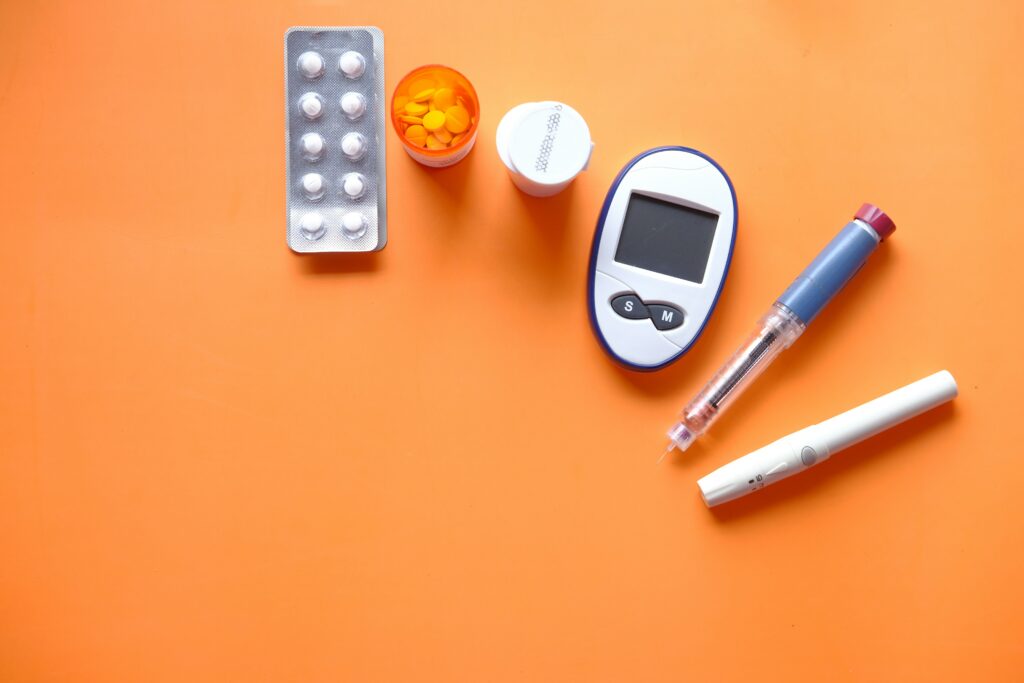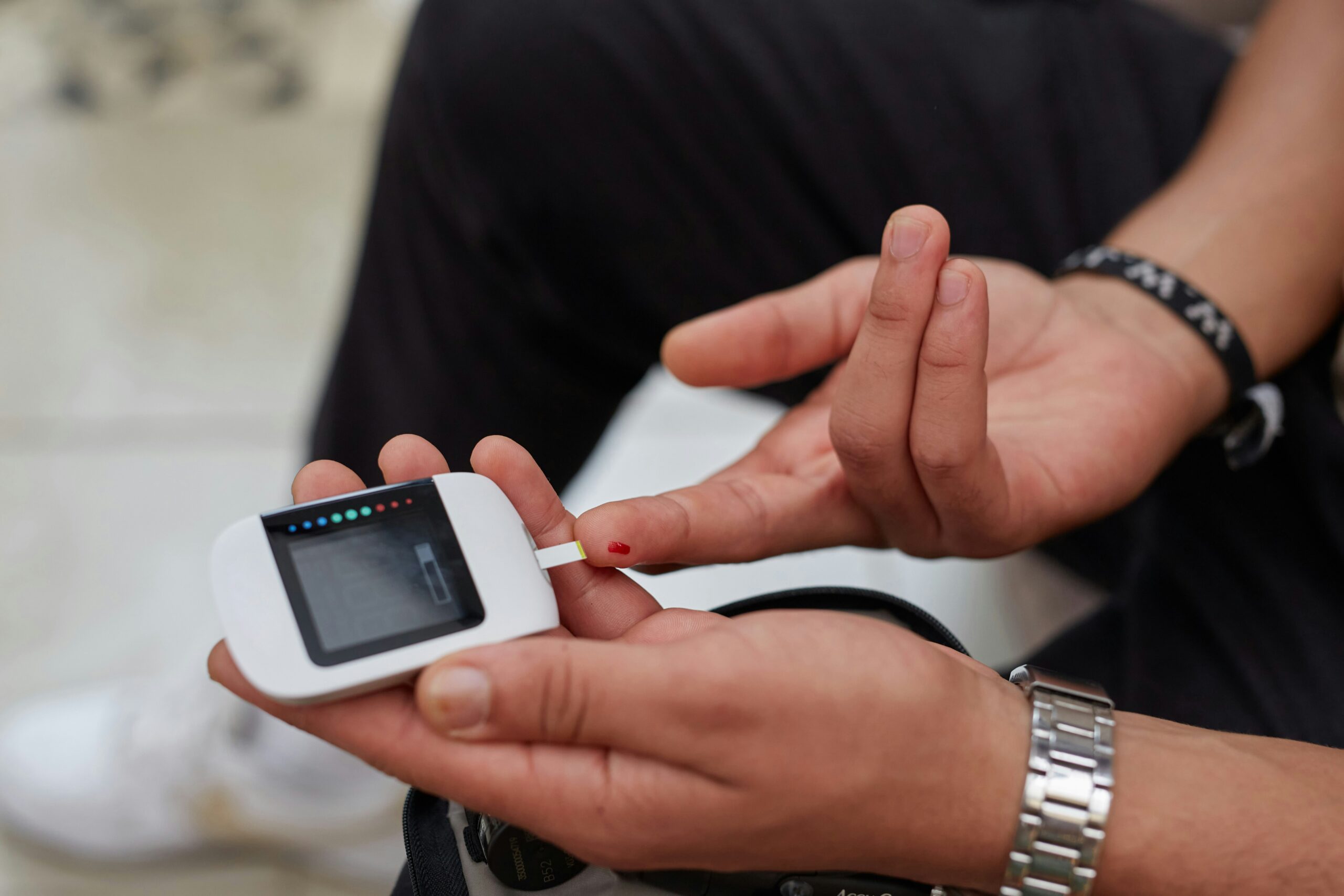Diabetes Mellitus, once considered as a rare disease has now evolved into a global health problem. Diabetes was first discovered by ancient Egyptians. In the past it was recognized by sweet urine or honeyed urine. Diabetes is a Greek word which means “passing through” and mellitus is a Latin word which means “sweet”. Diabetes is not just a disease of sugar metabolism but it is a multisystem disease affecting many systems that could prove fatal if not treated in time. Diabetes mellitus is a silent killer. There are two main types of diabetes, Type 1 and Type 2.

Diabetes Mellitus:
Diabetes Mellitus Type 1:
It is also known as insulin dependent diabetes mellitus (IDDM). It is an autoimmune disorder in which insulin producing cells of pancreas are destroyed leading to complete absence of insulin in the body.
Pathogenesis:
Diabetes develops when more than 80 percent of the normal insulin producing beta cells in the pancreas are lost due to an autoimmune response. The characteristic pathological feature of type 1 diabetes mellitus is “Insulitis”. Insulitis is an early feature presenting well before establishing diabetes. The beta cells of pancreas are infiltrated with mononuclear cells which contain macrophages, B cells, T cells and natural killer cells. Only the beta cells are destroyed in the pancreas while alpha cells producing glucagon and delta cells producing somatostatin are not affected by the immune system.
Islet cell antibodies are also present before the presentation of sign and symptoms of diabetes mellitus. There detection helps in the confirmation of the disease but cannot be used to predict the progression of the disease as they disappear with time. The most common antibodies are made against glutamic acid decarboxylase known as Anti-GAD. Anti-GAD is helpful in identifying late onset diabetes mellitus seen in middle age people.
Risk Factors for Diabetes Mellitus Type 1?
Diabetes mellitus runs in family so genes for diabetes plays a crucial role in the occurrence of the disease. It is also associated with HLA mutations. Presence of Anti GAD antibodies. Autoimmune diseases such as Addison’s disease, Thyroid disease, Pernicious anemia, Celiac disease and Vitiligo all have linkage with diabetes mellitus type 1. Environmental factors such as infection with Coxsackievirus, Cytomagaylo virus, Rubella and Ebstien Bar virus. Dietary factors such as smoked food as they contain nitrosamines and coffee. Bovine serum albumin (BSA) present in cow’s milk stress is also a contributing factor for diabetes mellitus.

Diabetes Mellitus Type 2:
It is more common than type one diabetes and it is due to the peripheral resistance shown by cells towards insulin. There is also inadequate secretory response by beta cells of pancreas. It is known as non-insulin dependent diabetes mellitus (NIDDM).
Pathogenesis:
Type 2 diabetes mellitus is due to insulin resistance.
1. Insulin resistance is associated with a syndrome called “syndrome X” or “metabolic syndrome”. It is defined by international diabetes federation as central obesity, hypertension of more than 130/85 mm hg, triglycerides more than 150 mg per dL, HDL less than 40 in men and less than 50 in women and fasting blood glucose level of more than 100mg/dL or already diagnosed as type 2 diabetes.
2. Pancreatic beta cell failure: At the time of diagnosis of type 2 diabetes mellitus 50 percent of beta cells have been lost. Deposition of amyloid in the islets of Langerhan is characteristic pathological feature of type 2 diabetes mellitus. An interesting factor is that the number of beta cell is reduced but the mass of the beta cells is not significantly altered. However secretion of glucagon is increased which further contributes to hyperglycemia.
3. Environmental factors like overeating, physical inactivity, aging and obesity also increases the risk for diabetes mellitus. There is 3 times increased risk of diabetes mellitus in patients with BMI more than 30 kg/m². Obesity exacerbate the effect of insulin resistance peripherally. In obesity there is increased plasma concentration of free fatty acids which reduces the uptake of glucose by making the muscle cells more resistant. Also the production of glucose is increased in liver when the levels of free fatty acid increases.
Diagnostic Criteria by WHO for Diabetes Mellitus:

Criteria 1:
If the person is symptomatic i.e having polyuria, polydipsia, polyphagia and weight loss with abnormal venous glucose on at least one occasion, fasting blood glucose is more than 126 gm/dL or random blood glucose is more than 200 mg/dL.
Criteria 2:
Asymptomatic patient should have abnormal venous glucose level on at least 2 occasions. A fasting blood glucose level of more than 126 gm/dL or random blood glucose level of more than 200 mg/dL.
Criteria 3:
When the HBA1C result is more than 6.5% the patient is said to be diabetic.
Oral Glucose Tolerance Test:
It is performed only for diagnosis of two specific conditions. One is borderline cases and the other one is gestational diabetes.
Clinical Features:
Glucose in renal tubules causes osmotic retention of water causing diuresis and this is known as polyuria. Now a physiological response occurs to polydipsia to maintain plasma volume it is called polydipsia. Weight loss is associated with diabetes and is due to increased glycogenolysis, lipolysis and gluconeogenesis. Swelling of lens cause blurred vision. Fatigue, numbness and tingling of hands and feet.
Symptoms of Type-1 diabetes mellitus develops quickly (in matter of days to weeks). Sometimes symptoms appear after an illness. Ketoacidosis is commonly seen in type 1 diabetes mellitus because there is complete absence of insulin which results in unrestrained lipolysis and proteolysis. This generate ketone bodies. When the ketone bodies exceed their metabolism rate it results into metabolic ketoacidosis.
In Type-2 diabetes mellitus hyperglycemia develops slowly. The threshold for glucose in renal tubules increases so that the osmotic symptoms are not very severe. Unlike type-1 diabetes mellitus in which there is absolute absence of insulin, in type 2 there is some insulin which suppresses lipolysis and proteolysis preventing ketogenesis and weight loss. That is why ketoacidosis is not seen in type 2 diabetes.
Hyperosmolar Non-Ketotic Coma:
Infections increases the production of counter regulatory hormones such as cortisol, growth hormone and catecholamines. All these contribute to hyperglycemia and dehydration giving us the features of Hyperosmolar Non Ketotic Coma.
Management of Diabetes Mellitus:
1. Dietary Management:
People with diabetes mellitus should have a diet that is low in sugar, high in fiber and low in fat as well.
2. Oral hypoglycemic Agents:
Metformin: This drug increases the insulin sensitivity which increases the uptake of glucose into the muscles cells peripherally. Metformin also decreases the absorption of glucose from the gut and inhibits hepatic gluconeogenesis.
Sulphonylureas: This drug increases the production of insulin b the pancreas. This drug is often prescribed to patient who are not obese and do not respond to dietary management alone.
Alpha-Glucosidase Inhibitors: Alpha Glucosidase is an enzyme that plays an important role in the absorption of glucose from the gut. This drug inhibits the enzyme and decreases the absorption of glucose from the gut into the blood stream.
Exentide: A synthetic GLP-1 agonist that increases the secretion of insulin. Exentide is prescribed to patient who wish to lose weight as well.
Insulin: Insulin cannot be given orally as it is a peptide and get metabolized by the enzymes present in the gut so it is given IV. It is the treatment of choice in cases of Ketoacidosis. Weight gain, peripheral edema, hypoglycemia and lipodystrophy are common side effects of using insulin.

Conclusion:
Diabetes Mellitus was once considered a rare disease but with the passage of time this disease has evolved into a global health issue. Diabetes has affect millions of people making it difficult to live a health and normal life. Timely monitoring of blood glucose is very important as it could cause a wide range of problems for the patient. Type-1 Diabetes Mellitus is an autoimmune response which decrease the number of beta cells producing insulin in the pancreas. Type-2 Diabetes Mellitus occurs due to increased resistance of cells to insulin. Usually Type-1 is seen in young patient and Type-2 in elderly but it is not a universal rule.
Both Type-1 and 2 presents significant challenges to the patients affecting their quality of life. However, with early detection, careful management and lifestyle modification individuals with diabetes can live a fulfilling life. Diabetes is a disease on which researches are being conducted on continuously and we hope a day will come that this world would become diabetes free. If you liked this blog and want to know more about human body go to my website Medrizz.com.
FAQs:
What is Diabetes Mellitus?
Diabetes Mellitus is a chronic condition that affects how the body processes blood sugar (glucose). It is characterized by high levels of glucose in the blood.
What causes Type 1 Diabetes?
Type 1 diabetes is caused by an autoimmune reaction that destroys the insulin-producing beta cells in the pancreas. The exact cause is unknown, but it is believed to involve genetic and environmental factors, such as viral infections.
What is the role of insulin in diabetes?
Insulin is a hormone produced by the pancreas that helps the body use or store glucose for energy. In Type 1 diabetes, the body produces little to no insulin, while in Type 2 diabetes, the body becomes resistant to insulin.
How is Ketoacidosis related to diabetes?
Diabetic ketoacidosis (DKA) is a serious complication primarily seen in Type 1 diabetes when there is a lack of insulin. This leads to uncontrolled lipolysis and the production of ketones, which can result in metabolic acidosis. DKA is a medical emergency and requires immediate treatment.
Can people with diabetes lead a normal life?
Yes, with proper management, people with diabetes can lead healthy and fulfilling lives. This includes maintaining regular blood sugar control, adhering to a healthy diet, exercising, and taking prescribed medications or insulin.

